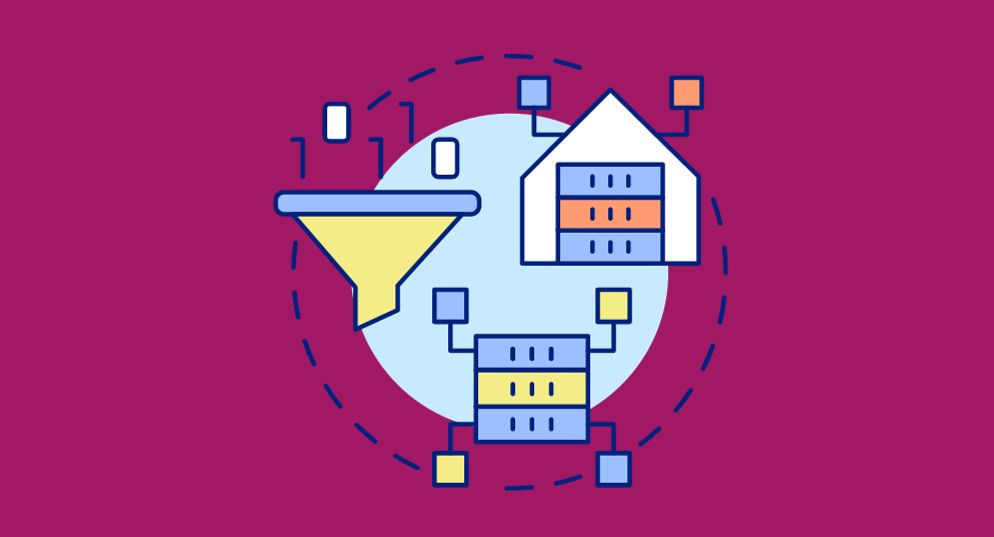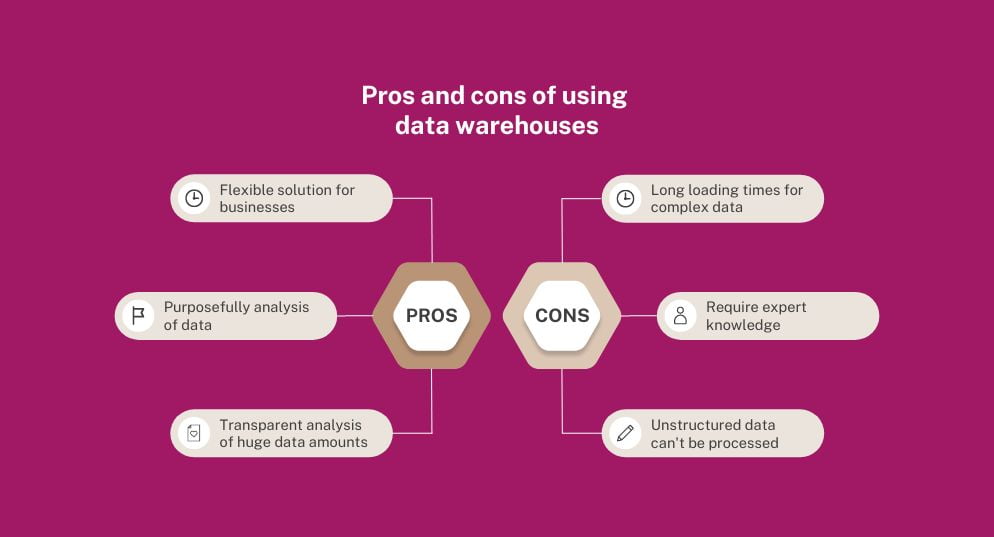DATA WAREHOUSE SIMPLY EXPLAINED: DEFINITION, ADVANTAGES & TOOLS
In this article you will find out everything you need to know about data warehouses. All information about definition, advantages, tools and application.
In this article
- What is a data warehouse?
- Data warehouse: Components and functions
- These are the pros and cons
- Data Warehouse vs. Data Lake
- Which data warehouse tools are available?
- This is how businesses use data warehouses
- FAQ
The most important in a nutshell
- A data warehouse is suitable for processing and evaluating company-related data
- Disadvantages include long loading times and that only structured data can be processed
- Access to data lake is easier but the method is not useful for processing structured data


What is a data warehouse?
Data warehouses describe a database which was specifically optimized for analysis. The system collects and processes relevant data from a summary of sources (e. g. apps or internal departments) and provides it clearly for businesses. The goal is to get a general overview of all important data.
A data warehouse is some kind of a data management system which supports business intelligence activities as well as it collects and saves huge amounts of data. The collected data passes through a formatting- and import process which compares existing information of the data warehouse. The following saving process ensures a simple data access. From this page, companies can derive important business data and optimize decision processes.
Data warehouse: Components and functions
A data warehouse normally consist of the following four elements:
- ETL solutions to prepare data for analysis
- Data mining functions
- Relational database to save and manage data
- Analysis applications to evaluate data and to visualize it easily
This is how a data warehouse works
Data warehouses don’t have a unified architecture. Instead, the specific requirements of a business determine the structure. When the business requirements are defined, conception follows. This includes the logical design (relationship between elements) and the physical design (best method to save and retrieve data).
During the design process of the data warehouse there are some steps to consider, including the frequency of data update, the supported system environment and the relationships between the different data groups.
The following process, the so-called “data warehousing”, normally takes place in four steps:
- Data acquisition + integration: Data is obtained from sources and loaded into the data warehouse
- Data storage: Data is held
- Data evaluation: Full analysis of structured data
- Data provision: Data is made available for analysis
These are the pros and cons
Businesses have specific advantages when using a data warehouse. The probably biggest advantage is that huge amounts of different data can be analyzed and evaluated purposefully. The data is easily accessible, goal oriented and relevant. That improves data quality and the decision making process within a company. Hereby, flexibility doesn’t get lost and businesses can, for instance, reduce data volume for an accurate verification.
Disadvantages include long loading times for complex data and increasing data volume. Furthermore unstructured data (e. g. audio) can’t be processed and live streaming isn’t possible either.
→ The access through a data warehouse is principally uncomplicated but associated with high effort.

Data Warehouse vs. Data Lake
Data Lake represents an alternative to the warehouse variant for data processing. Data lakes are better for unstructured data such as pictures or live streaming because they are easier accessible and therefore don’t require any expert knowledge. Furthermore, businesses have the opportunity to analyze bigger amounts of data on different ways to win new insights regarding relevant company data.
The data warehouse on the other hand has the advantage that structured data builds a good base for analysis which matches with the predefined business goals. The evaluation also happens much faster. And through the precise data evaluating processes, businesses can trust on the results and make decisions fast.
Use the strengths of both methods to bypass disadvantages
You don’t have to choose either of the two methods to evaluate data. Both ways complete each other and in combination provide a goal oriented approach to evaluate data. Data lake has more storage capacity and allows the deposit of big data quantities. The processed raw data can be structured and further processed with data warehouse tools.
Which data warehouse tools are there?
- integrate.io
- Informatica
- Oracle 12c
- IBM Infosphere
- Amazon Redshift
- Ab Initio Software
- ParAccel
- MarkLogic
- Cloudera
The tools belong to the ten most known and popular tools for processing data. Each of these tools has its individual advantages and was made for different application areas. For businesses it’s worth it to use at least one of these tools to make processes of data evaluation easier.
Cloud data warehouse: Which options do businesses have?
Cloud data warehouses become more popular to collect and process data from different sources. Data warehouses require a lot of effort in administration but cloud solutions provide a user friendly application which doesn’t even stress beginners. Furthermore, a cloud data warehouse ensures advantages regarding costs because there is no maintenance needed and businesses don’t have to invest in additional safety software.
But that doesn’t mean that internal solutions are bad. The opposite is the case. On-premise-servers ensure more safety and businesses have more control over data procession. So whether cloud-based solutions offer a better alternative is a matter of individual consideration.
This is how businesses use data warehouses
Businesses have many application possibilities with data warehouses. They primarily use it to provide reports to evaluate processes and to optimize them. This also results in more transparency to provide stakeholders a better insight into business processes. Processed data can also be used to determine information regarding commercial transactions.
Other application areas:
- Determination of resources and costs
- Getting information about business related KPIs
- Evaluation of concrete processes
- Structuring of data
It’s important to define goals and to know the requirements of users to use data warehouses properly. A data warehouse is a centralized collection of earmarked business data. Furthermore, changing data causes a lot of effort whereby inadequate goal planning may waste resources.
FAQ
Lastly, we will answer common questions regarding data warehouses.
ETL consists of the individual steps Extract (E), Transform (T) and Load (L). The ETL process ensures that data from different sources is integrated into the data warehouse. It’s used primarily in scenarios with large volumes of data (e. g. big data).
A data warehouse is normally larger than a terabyte and ranges across multiple areas. Data marts on the other hand are mostly smaller than 100 GB and are limited to a single purpose for one line business.
The costs of a data warehouse vary but typically it is between 350 and 400 euros annually. Cloud services and on-premise-solutions hardly differ in terms of costs.
A data warehouse ensures precise insights into business data which makes decision making easier and therefore helps to save costs. Stakeholders get access to visualized and analyzed data which was evaluated based on business related goals.
Contact us
Sources:
https://www.talend.com/de/resources/was-ist-data-warehouse/
https://www.bigdata-insider.de/was-ist-ein-data-warehouse-a-606701/
https://www.oracle.com/de/database/what-is-a-data-warehouse/
Bilder: © canva.com
